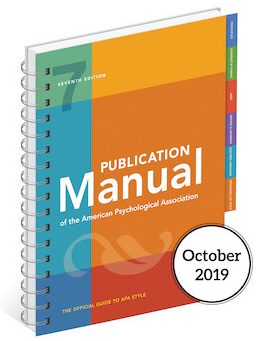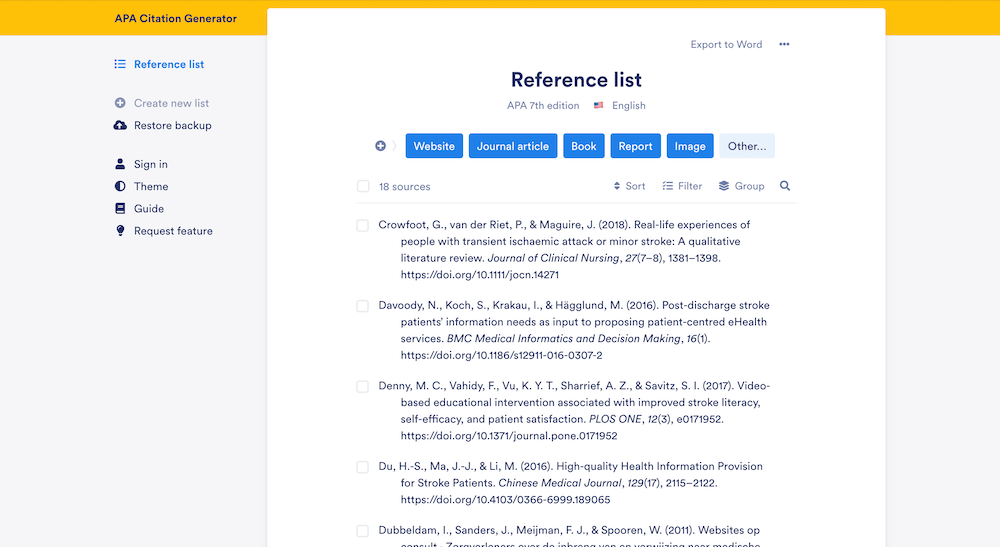APA 7th Edition (2020) | The 17 Most Notable Changes

In that time a lot of things have changed. Citing online material has become more common, the use of inclusive and bias-free language is increasingly important, and the technology used by researchers and students has changed.
The 7th edition addresses these changes by providing better and more extensive guidelines. This article outlines the biggest changes that you should know about.
References and in-text citations in APA Style
When it comes to citing sources, more guidelines have been added that make citing online sources easier and clearer.
In total, 114 examples are provided, ranging from books and periodicals to audiovisuals and social media. For each reference category, an easy template is provided to help you understand and apply the citation guidelines. The biggest changes in the 7th edition are:
- The publisher location is no longer included in the reference.
- Covey, S. R. (2013). The 7 habits of highly effective people: Powerful lessons in personal change. New York, NY: Simon & Schuster.
- Covey, S. R. (2013). The 7 habits of highly effective people: Powerful lessons in personal change. Simon & Schuster.
- The APA in-text citation for works with three or more authors is now shortened right from the first citation. You only include the first author’s name and “et al.”.
- (Taylor, Kotler, Johnson, & Parker, 2018)
- (Taylor et al., 2018)
- Surnames and initials for up to 20 authors (instead of 7) should be provided in the reference entry.
- Miller, T. C., Brown, M. J., Wilson, G. L., Evans, B. B., Kelly, R. S., Turner, S. T., . . . Lee, L. H. (2018).
- Miller, T. C., Brown, M. J., Wilson, G. L., Evans, B. B., Kelly, R. S., Turner, S. T., Lewis, F., Nelson, T. P., Cox, G., Harris, H. L., Martin, P., Gonzalez, W. L., Hughes, W., Carter, D., Campbell, C., Baker, A. B., Flores, T., Gray, W. E., Green, G., . . . Lee, L. H. (2018).
- DOIs are formatted the same as URLs. The label “DOI:” is no longer necessary.
- doi: 10.1080/02626667.2018.1560449
- https://doi.org/10.1080/02626667.2018.1560449
- URLs are no longer preceded by “Retrieved from,” unless a retrieval date is needed. The website name is included (unless it’s the same as the author).
- Streefkerk, R. (2019, October 11). APA 7th edition: The most notable changes [Blog post]. Retrieved from https://www.scribbr.com/apa-style/apa-seventh-edition-changes/
- Streefkerk, R. (2019, October 11). APA 7th edition: The most notable changes. Scribbr. https://www.scribbr.com/apa-style/apa-seventh-edition-changes/
- For ebooks, the format, platform, or device (e.g. Kindle) is no longer included in the reference, and the publisher is included.
- Brück, M. (2009). Women in early British and Irish astronomy: Stars and satellites [Kindle version]. https:/doi.org/10.1007/978-90-481-2473-2
- Brück, M. (2009). Women in early British and Irish astronomy: Stars and satellites. Springer Nature. https:/doi.org/10.1007/978-90-481-2473-2
- Clear guidelines are provided for including contributors other than authors and editors. For example, when citing a podcast episode, the host of the episode should be included; for a TV series episode, the writer and director of that episode are cited.
- Dozens of examples are included for online source types such as podcast episodes, social media posts, and YouTube videos. The use of emojis and hashtags is also explained.
Inclusive and bias-free language
Writing inclusively and without bias is the new standard, and APA’s new publication manual contains a separate chapter on this topic.
The guidelines provided by APA help authors reduce bias around topics such as gender, age, disability, racial and ethnic identity, and sexual orientation, as well as being sensitive to labels and describing individuals at the appropriate level of specificity. Some examples include:
- The singular “they” is endorsed as a gender-neutral pronoun.
- A researcher’s career depends on how often he or she is cited.
- A researcher’s career depends on how often they are cited.
- Instead of using adjectives as nouns to label groups of people, descriptive phrases are preferred.
- The poor
- People living in poverty
- Instead of broad categories, you should use exact age ranges that are more relevant and specific.
- People over 65 years old
- People in the age range of 65 to 75 years old
APA Paper format
In the 7th edition, APA decided to provide different paper format guidelines for professional and student papers. For both types, a sample paper is included. Some notable changes include:
- Increased flexibility regarding fonts: options include Calibri 11, Arial 11, Lucida Sans Unicode 10, Times New Roman 12, and Georgia 11.
- The running head on the title page no longer includes the words “Running head:”. It now contains only a page number and the (shortened) paper title.
- Running head: THE EFFECT OF GOOGLE ON THE INTERNET
- THE EFFECT OF GOOGLE ON THE INTERNET
- The running head is omitted in student papers (unless your instructor tells you otherwise).
- Heading levels 3-5 are updated to improve readability.
Mechanics of style
In terms of style, not much has changed in the 7th edition. In addition to some updated and better explained guidelines, there are two notable changes:
- Use only one space after a period at the end of a sentence.
- Use double quotation marks instead of italics to refer to linguistic examples.
- APA endorses the use of the singular pronoun they
- APA endorses the use of the singular pronoun “they”
APA 7th edition citation generator
With Scribbr’s free citation generator you can easily cite your sources according to the new 7th edition guidelines. It’s accurate, fast, and easy to use. Give it a try!
Free lecture slides
Are you a teacher or professor who would like to educate your students about the APA 7th edition changes? Great! You can download our free lecture slides, available for Google Slides and Microsoft PowerPoint.
Open Google SlidesDownload PowerPoint
Buying the new 7th edition APA Manual
Buy the APA Manual 7th edition today to keep up with the latest changes.
Frequently Asked Questions
- When will people start using the 7th edition APA Manual?
-
The American Psychological Association anticipates that most people will start using the 7th edition in the spring of 2020 or thereafter.
It’s best to ask your supervisor or check the website of the journal you want to publish in to see which APA guidelines you should follow.
- What is the most current edition of the APA manual?
-
The 7th edition APA Manual, published in October 2019, is the most current edition. However, the 6th edition, published in 2009, is still used by many universities and journals.
Cite this Scribbr article
If you want to cite this source, you can copy and paste the citation or click the “Cite this Scribbr article” button to automatically add the citation to our free Citation Generator.
Streefkerk, R. (2024, April 16). APA 7th Edition (2020) | The 17 Most Notable Changes. Scribbr. Retrieved April 22, 2024, from https://www.scribbr.com/apa-style/apa-seventh-edition-changes/
